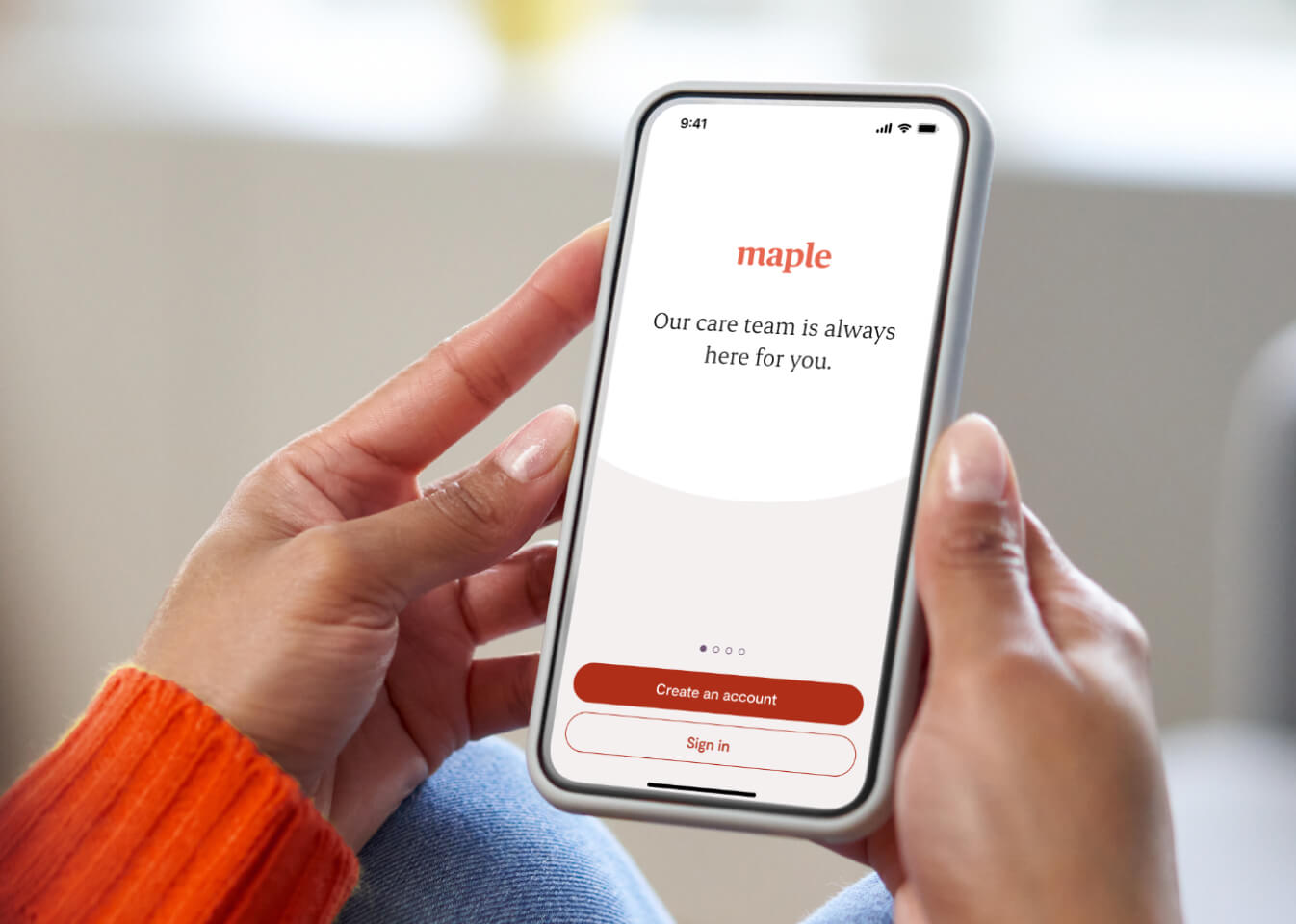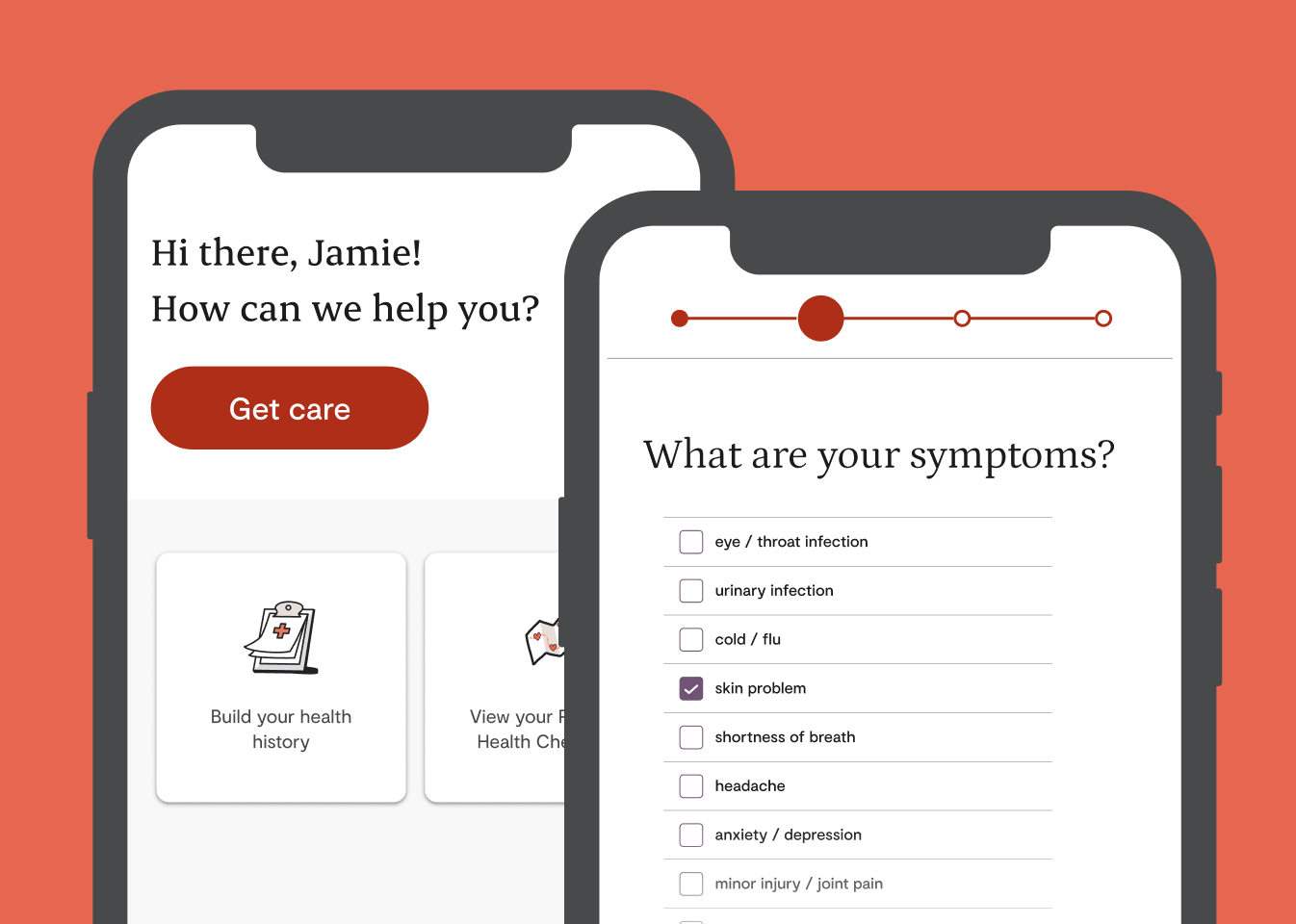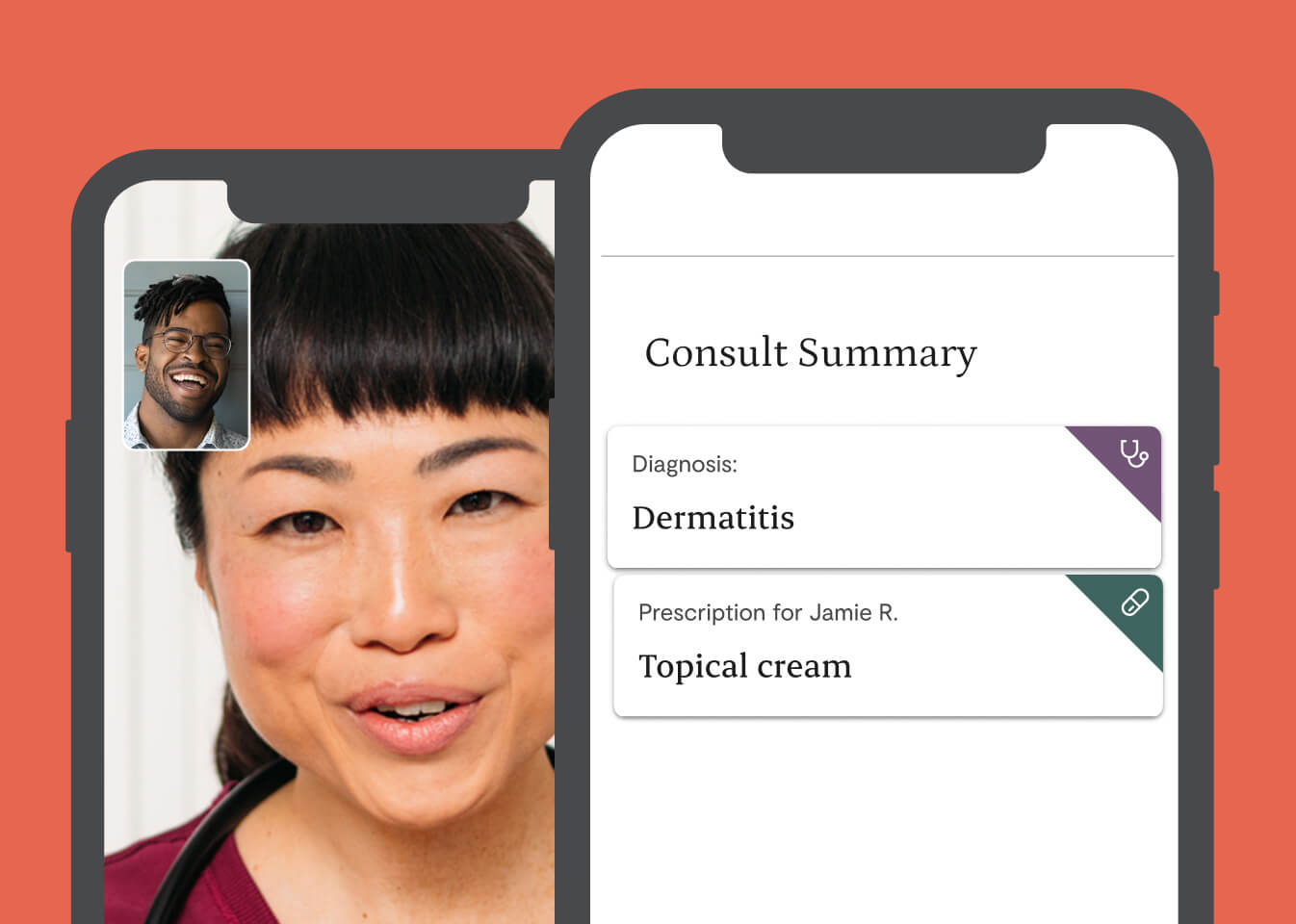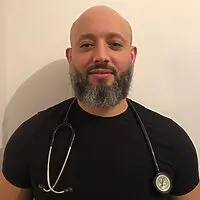COPD treatment, diagnosis & prescriptions
Skip the waiting room! Instantly connect with Canadian doctors for medical care from your phone, tablet or computer - any time, 24/7.

- Prescriptions available at a provider's discretion
- Speak to a doctor or nurse practitioner
- 24/7 availability
- Get connected in minutes
Trusted by millions of Canadians
- 4.8 rating30K+ App Store reviews
- 4.6 score5K+ Trustpilot reviews
Talk to a doctor about COPD treatment online
See a doctor or nurse practitioner today to get a new prescription or refill, at their discretion.
See a provider in three easy steps.
- 1
Register and become a member

- 2
Select the “Get care” button on our homepage

- 3
Connect with a Canadian-licensed doctor or nurse practitioner in minutes

Why Canadians love Maple
A fantastic way to get medical advice when you are unable to see someone in person. The app is so simple to use. Highly recommend. I am not a tech savvy person but the doctor was kind enough to patiently walk me through every step of the process. Thank you.
Saved me hours waiting in the ER.
Fast and effective tool for getting a diagnosis and prescription.
The doctor willingly took the time to explain things to me.
Very easy to book a therapist and get appointment receipts.
Frequently asked questions
About Chronic Obstructive Pulmonary Disease (COPD)
Yes, a Maple doctor can present you with a range of COPD treatment options. After asking you questions about your symptoms, the doctor can send you for x-rays and other tests to assist with making a diagnosis. Afterwards, the doctor will talk to you about your treatment options, and prescribe medications like puffers for ongoing management. In Ontario, Maple also works with respirologists, who are experts in COPD management.
Yes, our physicians can prescribe medications online during your consultation. Once you accept a prescription, you’ll have the option to pick it up from any pharmacy or to have it delivered right to your door at no additional cost.
You can visit our How it Works page to learn more.
Chronic obstructive pulmonary disease (COPD) is a chronic disease affecting the lungs that causes coughing, shortness of breath and sputum production. COPD causes inflammation and blockage of the lungs as well. In North America, it’s usually caused by prolonged exposure to chemicals that harm the lungs, like those found in cigarettes.
COPD is a general term. Most often, COPD stems from two types of respiratory conditions: chronic bronchitis and emphysema. It affects over 2 million Canadians over 35, and can significantly decrease mobility, and inhibit daily life.
Chronic bronchitis is a long-term inflammation of bronchi, which are the main passageways to the lungs. It also causes the overproduction of mucus, which further blocks air from traveling in and out of the lungs.
Emphysema is a progressive lung disease that damages the lung’s alveoli (air sacs), causing them to weaken and break. Healthy lungs have many small air sacs, whereas lungs affected by emphysema have large air sacs, because the walls between the small sacs have ruptured from damage. This makes it harder to push air out, causing fatigue and difficulty breathing.
There’s no cure for COPD, but the condition can be managed with proper care.
COPD doesn’t cause immediate symptoms. Signs of COPD develop over time, and as the lungs sustain more damage, complications begin to arise. At that point, symptoms include:
- Shortness of breath, especially during physical activity
- Fatigue
- Wheezing
- Coughing up mucus
- Prolonged cough, upwards of three months
- Blue lips or fingernail beds
- Frequent respiratory infections or pneumonia
- Unexplained weight loss
Many people with COPD experience flare ups, where symptoms like the ones above are triggered for extended amounts of time, sometimes causing hospitalization.
In most North American cases, COPD is caused by long term exposure to lung-irritants like chemicals.
In Canada, it’s most commonly found in smokers, and sometimes affects people who work around chemicals and debris, like on construction sites.
Emphysema and chronic bronchitis are common conditions that are synonymous with COPD, and exposure to cigarette smoke, especially if a person is already asthmatic, can also be a contributing factor.
Though it is extremely rare, COPD can also be the result of genetics. Alpha-1-antitrypsin is a protein produced by the liver, and some people have a natural deficiency that causes the liver to produce low amounts of Alpha-1-antitrypsin, causing poor lung development.
COPD can also occur because of age, as evidenced by the fact that a vast majority of those living with COPD are over 35.
COPD diagnosis can be difficult, because symptoms, especially in smokers, are common to several types of conditions that create difficulties with breathing, like asthma. Usually, to diagnose COPD a doctor will ask questions about your medical history, and look for details regarding exposure to any chemicals that could have damaged your lungs, including your smoking history.
There are also several tests that can help with COPD diagnosis, like chest X Rays, pulmonary function tests, arterial blood gas analysis (a test that shows how well your blood is carrying oxygen throughout your body), a CT scan to take a closer look at your lungs and determine the extent of the damage, or a lab test for the rare chance that you have alpha-1-antitrypsin deficiency.
There is treatment for COPD symptoms, but no COPD cure.
If you smoke, quitting cigarettes will make the most significant difference in your lung health.
Other COPD treatments include medications like inhalers (puffers) that make breathing easier. There are a few different types of inhalers that are common:
- Bronchodilator Inhalers: these open up the airways to the lungs. There are two common types — beta2-agonist and anticholinergics. Both can be used for quick relief and for longer term support.
- Combination Inhalers: these are taken daily as COPD maintenance treatment. They’re often a combination of several medicines in one inhaler. These medications help reduce swelling in the airways and shortness of breath longer-term.
- Nebulizer Medication: For people who have trouble using inhalers, a nebulizer mists the medication through a mask that’s held against the face
- Preventing illnesses that are hard on your lungs by getting flu shots and avoiding close proximity with those who are ill.
- In some cases, a home oxygen supply in combination with other medicines.
During a COPD flare up, treatment can range from inhalers to mechanical intervention, depending on the severity. Corticosteroid pills and antibiotics may be used to help in some cases. COPD treatment medications often also include Phosphodiesterase-4 Inhibitors or Mucolytics, taken orally, which help to loosen phlegm.
While both asthma and COPD have similar symptoms, like difficulty breathing, they’re not the same thing. COPD develops over time, and is the result of exposure to things like chemicals or cigarette smoke that degrades the lung long-term. Also, it gets worse over time.
On the other hand, asthma doesn’t necessarily continue to worsen, and isn’t directly related to long-term lung degeneration. Young people have asthma, too, whereas most people with COPD are over 35.
Critically, in-between symptoms, asthmatics return to normal lung capacity. People with COPD don’t.
Maple 101
Maple is a virtual care platform that connects you with doctors and other healthcare providers via text, audio, or video. After you log in to your Maple account, you can request an online consultation.
Consultations work similarly to in-person appointments — the doctor can complete an assessment by asking questions about your symptoms, going through your health history, and determining what treatment is right for you. If they think your condition is more serious, they may tell you to go to a clinic for an in-person examination.
As a Maple member, you get 24/7 access to virtual primary care online and more. You can connect with our network of providers via text, audio, or video call within minutes.
Pricing and Payment
Our membership costs $79.99/month and covers virtual care for patients and their families, including the primary account holder's spouse and any dependents.
For patients in eligible provinces, our membership includes:
- Access to daily primary care provider visits: One daily visit with a primary care provider for each family member in their household.
- Paediatric care: Covered paediatric primary care visits, available by appointment.
- Second medical opinions: access to a network of experts for a second opinion if diagnosed with a complex condition (e.g. cancer).
- Personal Health Check-Ins: A series of personalized, evidence-based proactive care screenings to maintain and improve health.
- iCBT courses: Access to iCBT (internet-based cognitive behavioural therapy) self-assessment and courses.
- Access to specialists in eligible provinces: Easy access to specialists on Maple within days, not months. No referral is needed.
- Specialist referrals in eligible provinces: Ability to be referred to a physician specialist for in-person care, if needed.
- Credit discounts: An $80 credit per month to be applied to a Maple specialist visit.
Please note that our membership cannot be combined with other offerings, such as private insurance coverage and provincial programs, where available. In some cases, membership fees can be covered by a Healthcare Spending Account (HSA) — check with your HSA provider for more details.
We accept all major credit cards, including AMEX cards, as well as Google and Apple Pay.
Security and Privacy
At Maple, we proudly prioritize privacy as a cornerstone of our virtual care services. We strictly adhere to privacy and healthcare legislation in Canada, such as PIPEDA and PHIPA regulations, to ensure patients' personal and health information remains completely private and safeguarded.
Our policies and consent processes are designed to be simple and easily understood, empowering individuals with control and a clear understanding of their healthcare journey. When using our services, a patient’s session is protected by a comprehensive security infrastructure and stringent data policies.
Patients also retain full control of their personal health information, medical records and test results at all times. Our approach is reinforced by consultations with leading experts, guaranteeing comprehensive policy frameworks that are reviewed at a regular cadence.
All providers delivering healthcare through Maple are licensed in Canada and governed by their licensing regulatory colleges, and in all instances, must act in accordance with the governing principles set out in the telemedicine policies of each medical regulator in the applicable province.
Regulators across Canada support and recognize the value of services like ours, and the way in which they can benefit patients, physicians, and Canada’s broader healthcare system by improving access to care and increasing efficiencies in the delivery of care.
Do you need medical care today?
Trusted, experienced doctors and nurse practitioners are ready to see you.
Maple is safe and effective for common non-emergency issues. If you believe you are experiencing an emergency, please call 911 or proceed to your nearest emergency room.










